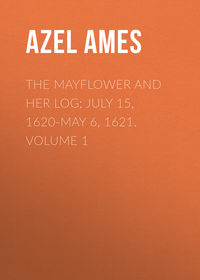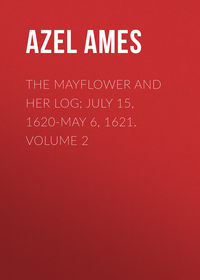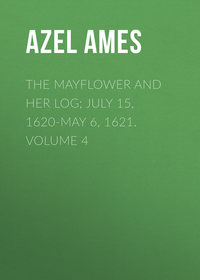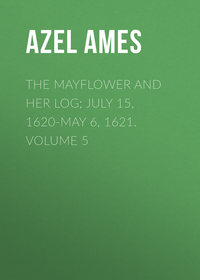 полная версия
полная версияThe Mayflower and Her Log; July 15, 1620-May 6, 1621. Volume 3
That "Master Williamson" was a veritable person at New Plymouth, in February and March, 1620/21, is now beyond dispute; that he must have been of the ship's company of the MAY-FLOWER is logically certain; that he was one of her officers, and a man of character, is proven by his title of "Master" and his choice by Standish and Mullens for exceptional and honorable service; that the position of "ship's-merchant" alone answers to the conditions precedent, is evident; and that such an officer was commonly carried by ships of the MAY-FLOWER class on such voyages as hers is indicated by the necessity, and proven by the facts known as to other ships on similar New England voyages, both earlier and later. The fact that he was called simply "Master Williamson," in both cases where he is mentioned, with out other designation or identification, is highly significant, and clearly indicates that he was some one so familiarly known to all concerned that no occasion for any further designation apparently occurred to the minds of Mullens, Carver, or Bradford, when referring to him. In the case of Master John Hampden, the only other notable incognito of early Pilgrim literature, the description is full, and the only question concerning him has been of his identity with John Hampden, the English patriot of the Cromwellian era. It is, therefore, not too much to assert that the MAY-FLOWER carried a "ship's-merchant" (or purser), and that "Master Williamson" was that officer. If close- linked circumstantial evidence is ever to be relied upon, it clearly establishes in this case the identity of the "Master Williamson" who was Governor Bradford's incognito, and the person of the same name mentioned a month earlier in "Master" Mullens's will; as also the fact that in him we have a new officer of the MAY FLOWER, hitherto unknown as such to Pilgrim literature. If Mr. Bowman's belief as to Giles Heale (see note) proves correct, we have yet another, the Surgeon.
The Carpenter, Gunner, Boatswain, Quartermaster, and "Masters-mates" are the only "petty officers" of the Pilgrim ship of whom any record makes mention. The carpenter is named several times, and was evidently, as might be expected, one of the most useful men of the ship's crew. Called into requisition, doubtless, in the conferences as to the condition of the SPEEDWELL, on both of her returns to port, at the inception of the voyage, he was especially in evidence when, in mid-ocean, "the cracking and bending of a great deck-beam," and the "shaken" condition of "the upper works" of the MAY-FLOWER, gave rise to much alarm, and it was by his labors and devices, and the use of the now famous "jack-screw," that the bending beam and leaking deck were made secure. The repairs upon the shallop in Cape Cod harbor also devolved upon him, and mention is made of his illness and the dependence placed upon him. No doubt, in the construction of the first dwellings and of the ordnance platform on the hill, etc., he was the devising and principal workman. He undoubtedly returned to England with the ship, and is known in history only by his "billet," as "the carpenter" of the MAY-FLOWER.
The Master Gunner seems to have been a man with a proclivity for Indian barter, that led him to seek a place with the "third expedition" at Cape Cod, thereby nearly accomplishing his death, which indeed occurred later, in Plymouth harbor, not long before the return of the ship.
The Boatswain is known, by Bradford's records, to have died in the general sickness which attacked the crew while lying in Plymouth harbor. The brief narrative of his sickness and death is all that we know of his personality. The writer says: "He was a proud young man, and would often curse and scoff at the passengers," but being nursed when dying, by those of them who remained aboard, after his shipmates had deserted him in their craven fear of infection, "he bewailed his former conduct," saying, "Oh! you, I now see, show your love like Christians indeed, one to another, but we let one another lie and die like dogs."
Four Quartermasters are mentioned (probably helmsmen simply), of whom three are known to have died in Plymouth harbor.
"Masters-mates" are several times mentioned, but it is pretty certain that the "pilots" (or mates) are intended. Bradford and Winslow, in "Mourt's Relation," say of the reappearance of the Indians: "So Captain Standish, with another [Hopkins], with their muskets, went over to them, with two of the masters-mates that follow them without [side?] arms, having two muskets with them: Who these "masters-mates" were does not appear." The language, "two of the masters-mates," would possibly suggest that there were more of them. It hardly seems probable that both the mates of the MAY-FLOWER would thus volunteer, or thrust themselves forward in such a matter, and it seems doubtful if they would have been permitted (even if both ashore at one time, which, though unusual, did occur), to assume such duty. Whoever they were, they did not lack courage.
The names of the petty officers and seamen of the MAY-FLOWER do not appear as such, but the discovery of the (evidently) nuncupative will of William Mullens—herein referred to—has perhaps given us two of them. Attached to John Carver's certificate of the particulars of this will, filed at Somerset House, London, are the names, "Giles Heale" and "Christopher Joanes." As Mr Mullens died Wednesday, February 21, 1620, on board the MAY-FLOWER in Plymouth harbor, on which day we know from Bradford' that "the Master [Jones, whose name was Thomas] came on shore with many of his sailors," to land and mount the cannon on the fort, and as they had a full day's work to draw up the hill and mount five guns, and moreover brought the materials for, and stayed to eat, a considerable dinner with the Pilgrims, they were doubtless ashore all day. It is rational to interpret the known facts to indicate that in this absence of the Captain and most of his crew ashore, Mr. Mullens, finding himself failing fast, sent for Governor Carver and—unable to do more than speak —dictated to him the disposition of his property which he desired to make. Carver, noting this down from his dictation, undoubtedly called in two of the ship's company (Heale very likely being the ship's-surgeon), who were left aboard to "keep ship," to hear his notes read to Mullens and assented to by him, they thus becoming the witnesses to his will, to the full copy of which, as made by Carver (April 2), they affixed their names as such. As there were then at Plymouth (besides savages) only the passengers and crew of the MAY-FLOWER, and these men were certainly not among the passengers, it seems inevitable that they were of the crew. That "Christopher Joanes" was not the Master of the ship is clear, because Heale's is the first signature, and no man of the crew would have dared to sign before the Captain; because the Captain's name was (as demonstrated) Thomas; and because we know that he was ashore all that day, with most of his men. It is by no means improbable that Captain Jones had shipped one of his kinsmen in his crew, possibly as one of the "masters mates" or quartermasters referred to (and it is by no means certain that there were not more than two), though these witnesses may have been quartermasters or other petty officers left on board as "ship- keepers." Certain it is that these two witnesses must have been of the crew, and that "Christopher Joanes" was not the Captain, while it is equally sure, from the collateral evidence, that Master Mullens died on shipboard. Had he died on shore it is very certain that some of the leaders, Brewster, Bradford, or others, would have been witnesses, with such of the ship's officers as could aid in proving the will in England. It is equally evident that the officers of the ship were absent when Master Mullens dictated his will, except perhaps the surgeon.
The number of seamen belonging to the ship is nowhere definitely stated. At least four in the employ of the Pilgrims were among the passengers and not enrolled upon the ships' lists. From the size of the ship, the amount of sail she probably carried, the weight of her anchors, and certain other data which appear,—such as the number allowed to leave the ship at a time, etc.,—it is probably not a wild estimate to place their number at from twenty to twenty-five. This is perhaps a somewhat larger number than would be essential to work the ship, and than would have been shipped if the voyage had been to any port of a civilized country; but on a voyage to a wild coast, the possibilities of long absence and of the weakening of the crew by death, illness, etc., demanded consideration and a larger number. The wisdom and necessity of carrying, on a voyage to an uninhabited country, some spare men, is proven by the record of Bradford, who says: "The disease begane to fall amongst them the seamen also, so as allmost halfe of their company dyed before they went away and many of their officers and lustyest men; as ye boatson, gunner, 3 quarter maisters, the cooke, and others."
The LADY ARBELLA, the "Admiral" of Governor Winthrop's fleet, a ship of 350 tons, carried 52 men, and it is a fair inference that the MAY-FLOWER, of a little more than half her tonnage, would require at least half as many. It is, therefore, not unlikely that the officers and crew of the MAY-FLOWER, all told, mustered thirty men, irrespective of the sailors, four in number (Alderton, English, Trevore, and Ely), in the Pilgrims' employ.








